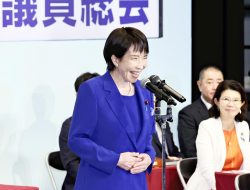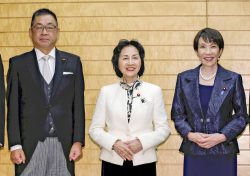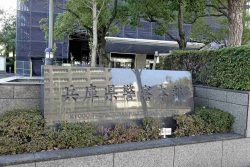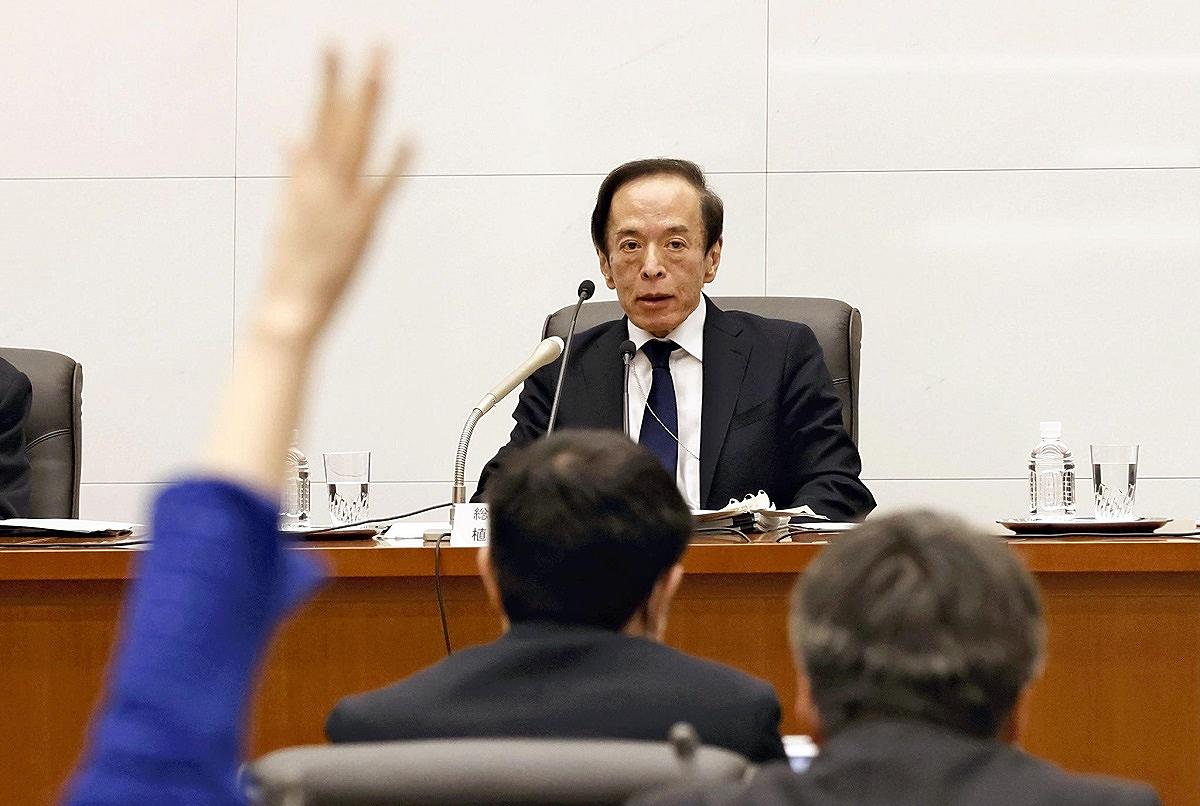
Bank of Japan Gov. Kazuo Ueda speaks at a news conference at the bank headquarters in Tokyo on April 10, the day after he took the helm.
8:00 JST, April 29, 2023
On April 9, economist Kazuo Ueda succeeded Haruhiko Kuroda as governor of the Bank of Japan, starting a new regime. Ueda needs to examine the central bank’s monetary policy over the quarter century since the late 1990s, when Japan’s economy fell into deflation, from the perspective of macroeconomic policy, including fiscal policy, and guide policy management accordingly.
The central bank should not simply rely on intuition, regardless of how politically appealing that approach can be.
To understand why, consider that in the spring of 2013, when the Japanese economy faced the major challenge of overcoming long-term deflation, the message that “deflation is a monetary phenomenon” was widely promoted.
Increasing the amount of money in circulation raises prices in the real economy. The idea is intuitive and easy to understand.
The reflationary policy view that “inflation and deflation are monetary phenomena” was behind Kuroda’s implementation of the “different-dimension” monetary easing in April 2013. It was thought that monetary policy could achieve the 2% inflation target quickly.
However, it is dangerous to rely on intuition alone.
In his book “Thinking, Fast and Slow,” Nobel Prize-winning economist Daniel Kahneman argues that human thinking consists of interaction between what are known as System 1, “intuitive and fast thinking,” and System 2, “deliberative and slow thinking.”
He gives an example of intuitive thinking that needs to be modified.
A bat and a ball together cost $1.10. If the bat costs $1 more than the ball, how much is the ball?
The first answer that comes to mind is 10 cents.
However, that answer is wrong. On closer examination, the correct answer turns out to be 5 cents for the ball and $1.05 for the bat.
Let’s check the central bank’s policy mechanism by “deliberative and slow thinking.”
In its monetary easing, the BOJ purchases Japanese government bonds and provides funds to banks. However, the BOJ does not disperse funds directly to consumers and businesses.
In other words, if firms and households do not borrow funds from banks and actively invest and consume, the funds will remain in the banks. As prices are said to be the thermometer of the economy, they will not rise unless economic activity is vigorous.
Just because the BOJ supplies funds to banks does not automatically mean that households and firms will decide to spend those funds. If firms and households are cautious about the future, they will not use the funds even if interest rates are low. The claim that deflation is a monetary phenomenon is, at the very least, an oversimplification of an economy affected by the complex behavior of firms and households.
Therefore, it is a mistake to simplify the theory, which is easy to understand at an intuitive level, and apply it to policy.
Another pillar of the reflationary theory was the assertion that deflation was the cause of Japan’s prolonged economic stagnation, and that Japan would revive once it got out of deflation.
Deflation in Japan began in 1998. After the bursting of the bubble economy, the bad loan problem worsened, the financial crisis spread, and the Japanese economy fell into a prolonged period of stagnation known as the “lost decade.”
Only in December 2013 did the Japanese government remove the word “deflation” from its monthly economic report. Deflation had continued for 15 years.
If deflation is a monetary phenomenon and the cause of economic stagnation, then the BOJ’s monetary policy should have been able to solve the problem.
However, the results of the BOJ’s 10-year experiment in “different-dimension” large-scale monetary easing show that deflation is the result, not the cause, of long-term stagnation.
To begin with, many economists thought deflation was a consequence, not a cause, of the prolonged stagnation of the Japanese economy. Indeed, even with continued massive monetary easing, the 2% inflation target still has not been reached.
However, the consumer price index rose above 2% in 2022 mainly due to higher import prices, but households suffered as wage growth failed to keep pace. With prices so high and the Japanese economy not doing any better, the claims of the reflationary camp lost credibility.
Even so, dismissing Kuroda’s easing measures as a failure would be overly critical. The monetary easing measures have corrected the yen’s excessive appreciation, which had plagued the Japanese economy. The measures also halted deflation. Large corporations have continued to post record profits and have added over 4 million jobs. The positive effects of the policies have outweighed the negative ones.
Now let’s look at longer-term Japanese macroeconomic policy, combining monetary and fiscal policy.
Many economists criticize Japan’s macroeconomic policy since the early 1990s for resulting in the worst government debt among major advanced economies, failing to achieve the 2% inflation target, and causing prolonged stagnation.
However, former IMF chief economist Olivier Blanchard offers an interesting perspective in his recent book, “Fiscal Policy under Low Interest Rates.”
He argues that Japan’s macroeconomic policies should be viewed as somewhat successful, as aggressive fiscal and monetary policies compensated for sluggish private-sector demand.
After the bubble economy burst, Japan’s economic growth rate since 1992 has averaged 0.8%, which is certainly below an OECD average of 2.0%.
However, he points out that much of this is due to a decline in the population growth rate.
Productivity growth measured as output per worker has been 0.6%, similar to 0.5% for the EU major advanced countries. Productivity growth measured as output per hour has been 1.3%, higher than the EU’s 1.0% and slightly lower than the United States’ 1.7%.
The BOJ should examine this perspective and apply it to monetary policy.
The fundamental problems that Blanchard’s view brings into focus are sluggish private demand and excessive savings. In short, consumers do not buy goods and services, and companies tend to hoard retained earnings instead of investing.
Therefore, the BOJ and the government must coordinate on macroeconomic policy to address the underlying problem.
The prescription is to review the balance of burdens and benefits in the social security system, provide a path to manage the massive government debt, eliminate uncertainty about the future, and stimulate consumption.
Another urgent task is to address the declining birthrate and to learn to cope with a society with a declining population. And, of course, price stability is vital.
We need various policies to revitalize the Japanese economy, such as the promotion of growth strategies and structural reforms, including labor market reforms.
In Japan, politicians have avoided addressing these reforms because they would impose pain on older people and other specific population groups.
If we continue to avoid the real problem, we must further prolong monetary easing measures and aggressive fiscal spending, which are undesirable in the medium to long term. After all, they increase future risks. Therefore, we should review how long the massive monetary easing can continue and how sustainable the fiscal situation can be.
Before taking office as BOJ governor, Ueda stated in the Diet, “The mission given to me is not to formulate and implement some magical, special monetary easing policy.”
Exactly.
Of course, appropriate monetary policy is essential to achieve stable economic growth.
However, monetary policy is not a magic wand that will solve all the problems of the Japanese economy.
Political Pulse appears every Saturday.
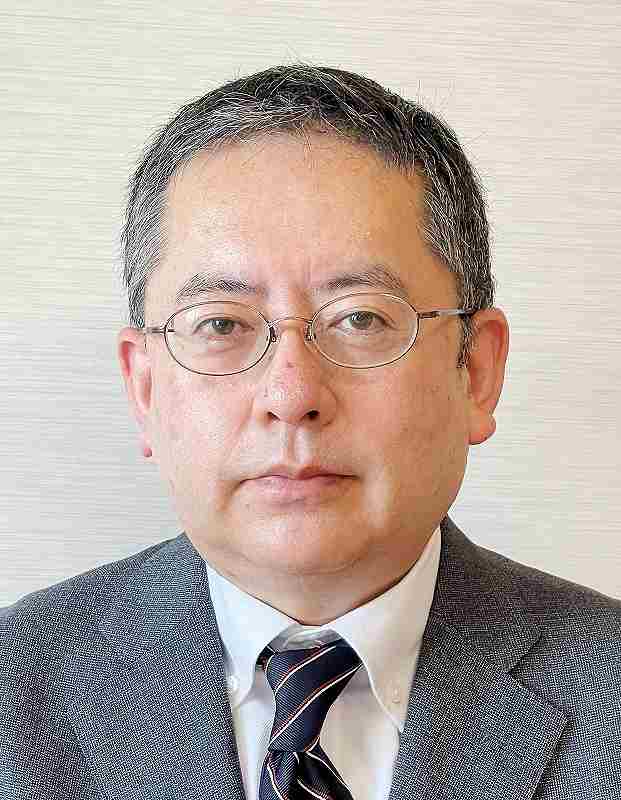
Akihiro Okada
Okada is an editorial writer for The Yomiuri Shimbun.
"Editorial & Columns" POPULAR ARTICLE
-

Violations of Subcontract Law: Major Automakers Must Eliminate Old Practices
-

Local Governments’ Tax Revenues: Devise Ways to Correct Imbalances in Tax Sources
-

5 Japanese Business Dinner Mistakes to Avoid — and What They Taught Me About Business in Japan
-

Heavy Rains in Asia: Support for Victims, Flood-Control Measures Urgently Needed
-

Rice Coupons: A Misguided Approach to Countering Rising Prices
JN ACCESS RANKING
-

Keidanren Chairman Yoshinobu Tsutsui Visits Kashiwazaki-Kariwa Nuclear Power Plant; Inspects New Emergency Safety System
-

Imports of Rare Earths from China Facing Delays, May Be Caused by Deterioration of Japan-China Relations
-

University of Tokyo Professor Discusses Japanese Economic Security in Interview Ahead of Forum
-

Japan Pulls out of Vietnam Nuclear Project, Complicating Hanoi’s Power Plans
-

Govt Aims to Expand NISA Program Lineup, Abolish Age Restriction



